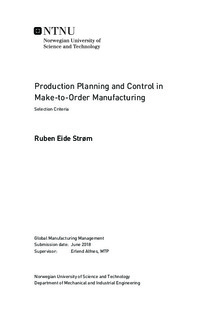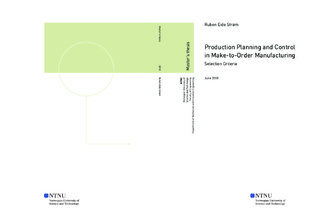| dc.description.abstract | Purpose: The purpose of this thesis is to identify appropriate Production Planning and Control (PPC) methods in a Make to Order (MTO) manufacturing environment. This is done through two steps. First, the MTO environment needs to be defined. This narrows down the field of appropriate PPC methods, as well as highlights the characteristics of the environment in which the methods are to be applied. By looking at the variety in systems that has undergone review, these characteristics should be defined under two categories: complexity and dynamism. Complexity represents numeral values that are known, such as Bill of Material (BOM), number of routings, product mix (number of products), and number of converging or diverging routings. Dynamism represents numeral values that vary over time in a significant way, such as demand fluctuation, processing time variation, and rate of innovation (new product introduction). Using these environmental characteristics, PPC methods will be compared by how they perform in the different scenarios. Key PPC methods as suggested by Stevenson et al. (2005) are under consideration: MRP (ERP), Kanban, CONWIP, DBR (TOC), POLCA and WLC. How these methods perform in various scenarios relating to the environmental characteristics, and how the methods address the important performance issues found in the MTO industry relating to their competitiveness, will be compared in order to provide a guide as to which PPC method to choose.
Design: A literature review will be conducted, identifying key literature that holds validity, both in terms of PPC methods and MTO environmental characteristics. In addition the Key Performance Indexes found in the MTO industry will be used as a base mark for PPC performance given the various manufacturing environments described.
Findings: The MTO environment were found to include a number of definitions. High-Variety/Low-Volume production are for the most part some kind of MTO manufacturing. In addition, Engineer-to-Order (ETO) share a number of traits when compared to MTO, as the production part of the Customer Order Decoupling Point (CODP) is shared. Engineering and reengineering becomes part of the environmental factors (complexity and dynamism) that impact the applicability of a PPC method.
Of the six key PPC methods in the MTO industry defined by Stevenson et al. (2005), four showed the most promise for optimal performance in the MTO environment identified. Kanban does not perform well in MTO other than as a support for a manufacturing line, and MRP uses pure push logic, commonly found in any MTO company that has yet to review their PPC. In certain scenarios push does perform better, at least when compared to the identified PPC methods. If complexity and dynamism reach very high levels, the variable inputs needed to build any of the other PPC systems are impossible to define. If the complexity and dynamism lie within acceptable levels, all four could be viable.
WLC is the system that shows the most promise. This is because two other PPC methods share many traits with WLC, namely CONWIP and DBR. This lowers the barrier of implementation, and allows for a gradual maturing of the system, which can start out as a loose CONWIP/DBR, and over time increase the number of deciding inputs to become a WLC. POLCA is a stricter system than WLC (especially if a simple, loose CONWIP/DBR is used as a base), but does show great promise. Of the two systems, WLC handle dynamism better, whereas POLCA handle complexity better.
Research limitations: There is severe limitations when studying PPC methods without a case study. Because the parameters of each manufacturing environment receives varying degree of attention in the reviewed literature, a case study would help pinpoint crucial environmental factors. It would also help in showing the actual functionality of the studied methods.
Value: The thesis will hold value for companies that fall under the MTO category defined in the thesis, given that they need to select a PPC system to improve production performance, and address any performance issues they may have.
Keywords: Production planning and control, kanban, CONWIP, WLC, POLCA, DBR, TOC, MTO, ETO, HVLV, customization | |

